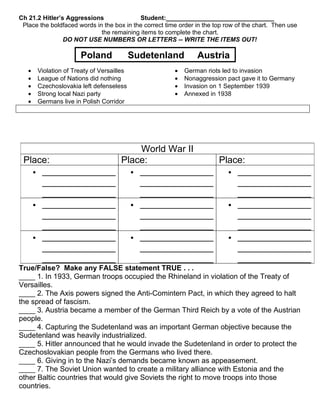
Ch 21.2 questions
- 1. Ch 21.2 Hitler’s Aggressions Student:_______________________________ Place the boldfaced words in the box in the correct time order in the top row of the chart. Then use the remaining items to complete the chart. DO NOT USE NUMBERS OR LETTERS -- WRITE THE ITEMS OUT! Poland Sudetenland Austria • Violation of Treaty of Versailles • German riots led to invasion • League of Nations did nothing • Nonaggression pact gave it to Germany • Czechoslovakia left defenseless • Invasion on 1 September 1939 • Strong local Nazi party • Annexed in 1938 • Germans live in Polish Corridor World War II Place: Place: Place: • ______________ • ______________ • ______________ ______________ ______________ ______________ ______________ ______________ ______________ • ______________ • ______________ • ______________ ______________ ______________ ______________ ______________ ______________ ______________ • ______________ • ______________ • ______________ ______________ ______________ ______________ ______________ ______________ ______________ True/False? Make any FALSE statement TRUE . . . ____ 1. In 1933, German troops occupied the Rhineland in violation of the Treaty of Versailles. ____ 2. The Axis powers signed the Anti-Comintern Pact, in which they agreed to halt the spread of fascism. ____ 3. Austria became a member of the German Third Reich by a vote of the Austrian people. ____ 4. Capturing the Sudetenland was an important German objective because the Sudetenland was heavily industrialized. ____ 5. Hitler announced that he would invade the Sudetenland in order to protect the Czechoslovakian people from the Germans who lived there. ____ 6. Giving in to the Nazi’s demands became known as appeasement. ____ 7. The Soviet Union wanted to create a military alliance with Estonia and the other Baltic countries that would give Soviets the right to move troops into those countries.
- 2. ____ 8. According to the German-Soviet nonaggression pact, Germany and the Soviet Union agreed not to attack each other. ____ 9. The Western democracies expected Stalin to make the German-Soviet nonaggression pact with Hitler. ____10.The Polish army had no hope of defeating Hitler’s far stronger army. _____1. Germany and Italy hid their intention to conquer Europe a. from an all-powerful League of Nations. b. under the mask of fighting Communism. c. from their own citizens. d. before Europe united to attack Germany. _____2. The philosophy behind appeasement was that a. the other nations of Europe were Nazi sympathizers. b. War, if it came, should be started on France’s terms, not Germany’s. c. War had been outlawed by the Kellogg-Briand Pact. d. It was important to keep the peace at all costs. _____3. Stalin and Hitler signed a nonaggression pact because a. they trusted each other b. they shared a belief in world domination c. they were buying time from each other d. they wanted to unite against the Western democracies _____ 4. Regaining the Polish Corridor was an important German objective because a. the land was once Prussian territory b. Poland already had access to the sea in other ways c. Many Pole lived in German territory. d. It was good terrain in which in use tanks Following the outbreak of the Spanish Civil War, Adolf Hitler and Benito Mussolini began referring to themselves as the _____________________________________________________________. By the end of 1936, Japan and Germany had signed an agreement that pledged to stop the spread of ____________________________________________________________________________. While the League of Nations looked on, in March of 1938 Hitler began the first of his “expansions” of the Third Reich by conquering the nation of _________________________________________. Nazi propaganda likened nearby Czechoslovakia to what kind of weapon?_________________ As the Third Reich grew, a strong Nazi movement swept across the German-speaking region of Czechoslovakia known as _______________________________________________________. Hitler’s invitation to British Prime Minister Neville Chamberlain, French premier Edouard Daladier, and Italy’s Mussolini led to the _______________________________________________________. Neville Chamberlain’s policy of appeasement – attempting to preserve peace by yielding to an aggressor’s demands – prompted him to announce that he had achieved ________________________________________________________. Hitler’s virtually unopposed aggression underscored the ineffectiveness of the _____________________________________________________________________________. Encouraged by Hitler’s successful conquests, in the spring of 1939 Mussolini seized the nation of _____________________________________________________________________________.
- 3. In August 1939 Russian leader Joseph Stalin’s secret negotiations with Hitler led to the _____________________________________________________________________________.
